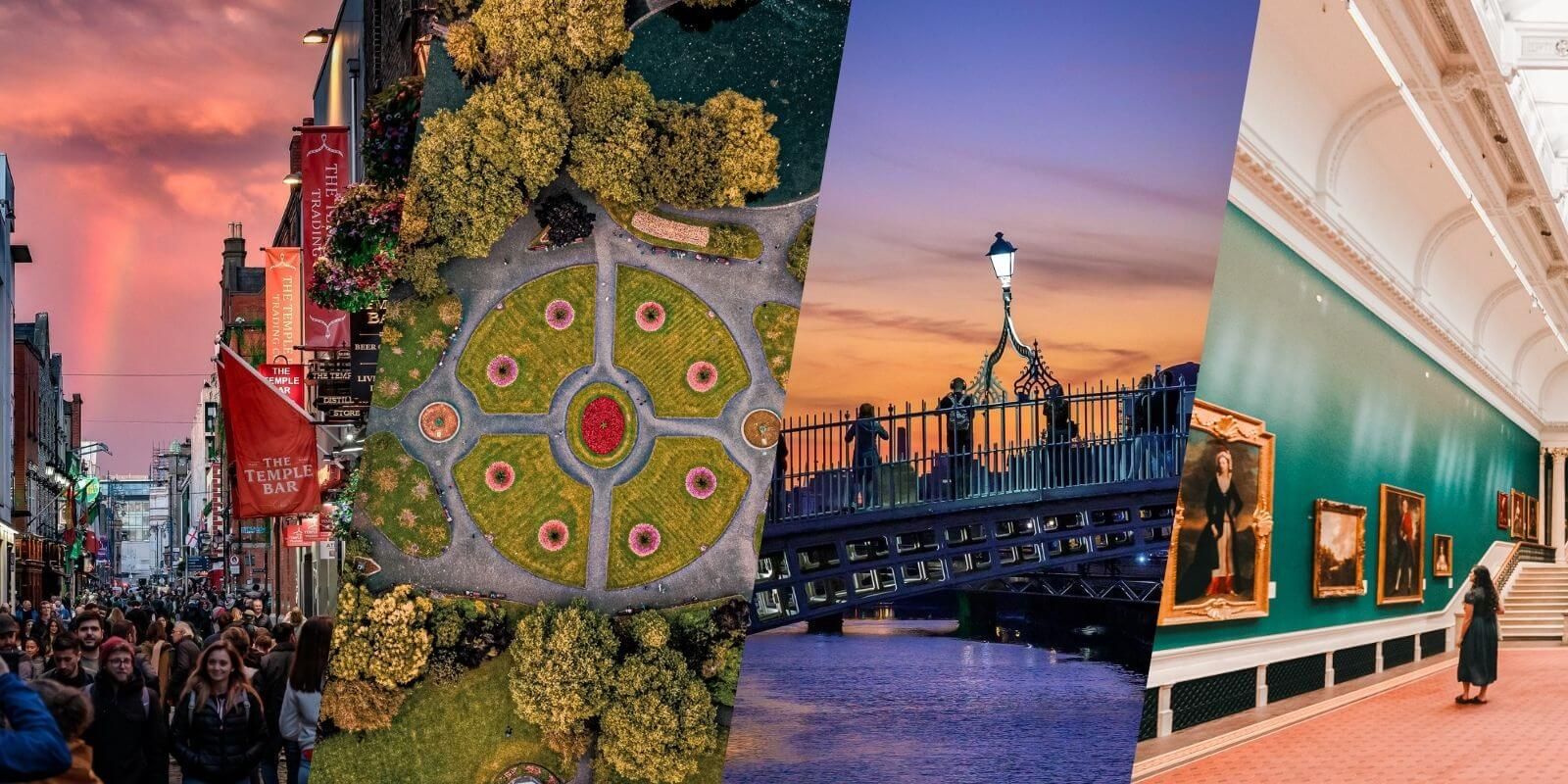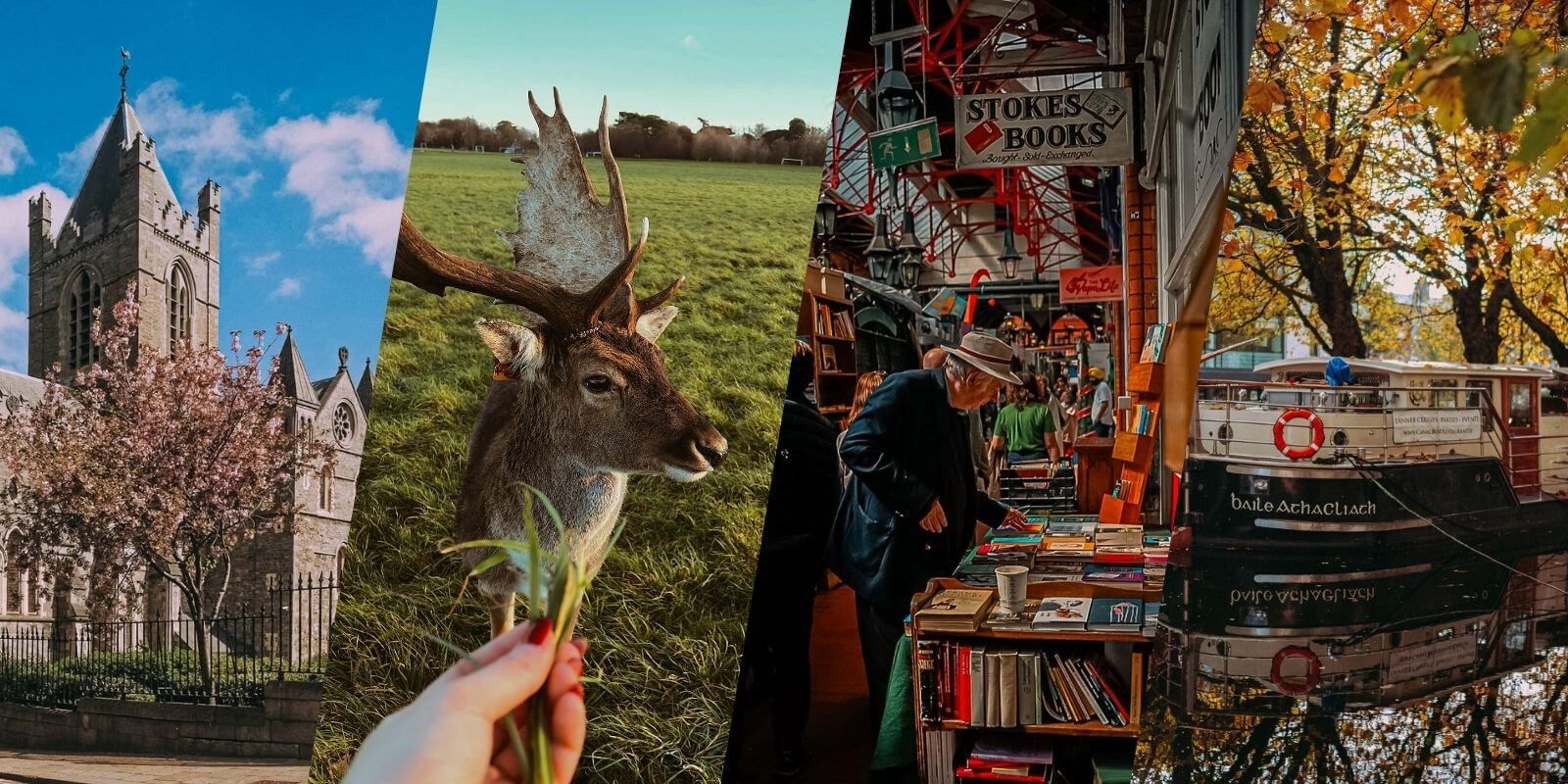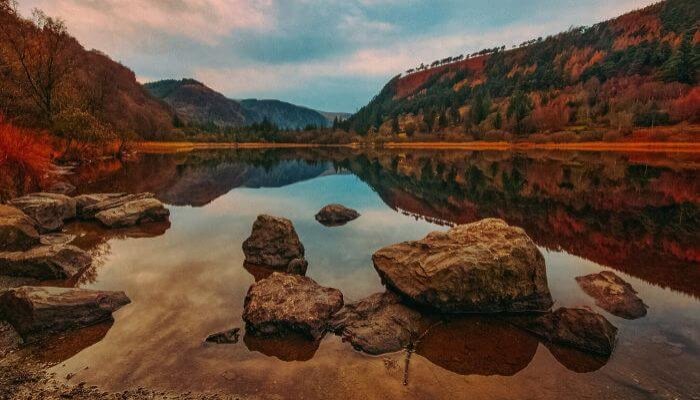Best Nature Day Trips from Dublin:
-
Discover Ireland’s stunning natural escapes just a short drive or train ride from Dublin, including iconic spots like the Cliffs of Moher, Wicklow Mountains, Howth and Glendalough. Perfect for nature lovers seeking dramatic cliffs, peaceful lakes, rich wildlife and historic landscapes.
-
Plan your trip with smart travel tips such as realistic itineraries, flexible transportation options (car rental or public transit) and essential packing advice for unpredictable Irish weather, ensuring a comfortable and hassle-free outdoor adventure.
-
Enjoy year-round seasonal highlights with spring’s blooming landscapes, summer’s warm weather and long days, autumn’s vibrant foliage and winter’s peaceful crispness, helping you choose the best time to savour Ireland’s breathtaking scenery.
Embarking on a journey from Dublin opens up a world of natural wonders waiting to be explored. For nature lovers, the lush landscapes and stunning views just beyond the city limits offer a perfect escape from urban life. Imagine wandering through rolling hills, rugged coastlines and tranquil forests, all while breathing in the fresh, crisp air. Whether you’re seeking dramatic cliffs, serene lakes, or vibrant wildlife, these day trips promise an unforgettable experience. From the iconic beauty of the Cliffs of Moher to the magic of Glendalough, there’s an adventure for every kind of explorer. Pack your bags, grab your camera and get ready to uncover the top breathtaking day trips from Dublin that will immerse you in the captivating beauty of Ireland's great outdoors. Your unforgettable escape beckons just a short drive away!
How to plan your day trips from Dublin
Planning day trips from Dublin, especially for nature enthusiasts, requires a bit of forethought to ensure you maximize your experience. Start by considering the distance and travel time to each destination. While some of the most breathtaking spots are just a short drive away, others may require more travel time. It's essential to plan your itinerary realistically, allowing enough time to enjoy the scenery and the activities available. Use online maps and travel guides to estimate how long you'll spend on the road and figure out the best routes to take.
When planning your day trips, it’s also important to consider transportation options. While renting a car offers the most flexibility, especially for reaching remote areas, public transportation in Ireland is reliable and can be a great alternative. Trains and buses connect many of the top nature destinations from Dublin, making them accessible without the need for a vehicle. Research the schedules in advance and plan your departure and return times accordingly to avoid any last-minute hassles.
Lastly, packing wisely is crucial for a successful day trip. Ireland's weather can be unpredictable, so dress in layers and bring waterproof gear to stay comfortable regardless of the conditions. Don’t forget essentials like a good pair of hiking boots, snacks, water and a fully charged phone (or camera) to capture the stunning landscapes. Preparing a small day pack with these items will ensure you’re ready to fully enjoy your adventure without any hiccups.
The best time of year for nature day trips
Ireland’s natural beauty can be appreciated year-round, but certain times of the year offer unique advantages for day trips. Spring (March to May) is a fantastic season to explore the outdoors, as the landscape bursts into life with vibrant greenery and blooming flowers. The weather is generally mild and the longer daylight hours provide ample time for exploration. Spring is also less crowded compared to the peak summer months, allowing for a more serene experience.
Summer (June to August) is the most popular time for nature day trips, thanks to the warm weather and extended daylight. This is the ideal season for hiking, coastal walks and outdoor picnics. However, it’s also the busiest time, so be prepared for more tourists at popular sites. To make the most of your summer adventures, consider starting your day early to beat the crowds and enjoy the tranquillity of the morning.
Autumn (September to November) brings a different kind of charm to Ireland’s landscapes. The changing foliage creates a stunning tapestry of reds, oranges, and yellows. The weather remains relatively mild, making it a comfortable time for outdoor activities. Additionally, the tourist crowds begin to dwindle, offering a more peaceful experience. Winter (December to February), while colder, can also be magical with its crisp air and occasional snowfall, ideal for those who don’t mind bundling up for a quieter, more solitary experience.
Cliffs of Moher
The Cliffs of Moher, located on the west coast of Ireland, are among the most iconic natural landmarks in the country. Rising over 700 feet above the Atlantic Ocean, these dramatic cliffs offer inspiring views that will leave you breathless. The cliffs stretch for about 5 miles, providing ample opportunities for exploration and photography. On a clear day, you can see as far as the Aran Islands and the mountains of Connemara.

A visit to the Cliffs of Moher is not just about the stunning views, it's also an opportunity to learn about the unique geology and ecology of the area. The Cliffs of Moher Visitor Experience, an eco-friendly visitor centre built into the hillside, offers interactive exhibits that provide insight into the natural and cultural history of the cliffs. The centre also features a viewing platform where you can enjoy uninterrupted views of the coastline.
For those looking for a more immersive experience, the cliff walk is a must. This trail runs along the edge of the cliffs, offering spectacular vistas at every turn. The walk can be challenging in parts, but the rewards are well worth the effort. Along the way, you’ll encounter diverse flora and fauna, including puffins, guillemots and razorbills. The cliffs are also a designated UNESCO Global Geopark, highlighting their significance and natural beauty.
Kilkenny & Ireland’s Medieval East
Step back in time with a day trip to Kilkenny, a well-preserved medieval city that blends historical intrigue with modern flair. Explore Kilkenny Castle, stroll the Medieval Mile, or drop by the Smithwick’s Brewery for a cheeky pint.
Some tours combine Kilkenny with a visit to Glendalough or the Wicklow Mountains, giving you the best of both worlds, history and natural beauty.

Howth
Just a short drive or train ride from Dublin, Howth is a picturesque peninsula that offers a perfect blend of coastal scenery and charming village life. The area is known for its rugged cliffs, scenic trails and abundant wildlife. One of the most popular activities in Howth is the cliff walk, which offers stunning views of the Irish Sea, Dublin Bay and the surrounding countryside. The trail is well-marked and varies in difficulty, making it accessible for all fitness levels.
Howth is also a haven for birdwatchers, with a variety of seabirds nesting along the cliffs. Keep an eye out for cormorants, gannets and even seals basking on the rocks below. The area’s natural beauty is complemented by its rich maritime history, evident in the charming fishing village of Howth. The village is home to a bustling harbour, where you can watch fishing boats come and go, and enjoy fresh seafood at one of the many local restaurants.

In addition to its natural attractions, Howth boasts several historical sites, including Howth Castle and the ancient ruins of St. Mary’s Abbey. The castle, which has been home to the St. Lawrence family for over 800 years, is surrounded by beautiful gardens and woodland. Exploring Howth offers a delightful mix of outdoor adventure and cultural exploration, making it an ideal day trip from Dublin.
Boyne Valley & Newgrange
Newgrange is one of the oldest known man-made structures in the world (yes, even older than the Pyramids of Egypt). This prehistoric passage tomb is aligned with the winter solstice, when sunlight illuminates its inner chamber.
Located in the lush Boyne Valley, the area is also home to the Hill of Tara, ancient seat of Irish High Kings, and Monasterboice, which features incredible high crosses and early Christian ruins.

Wicklow Mountains National Park
Wicklow Mountains National Park, located just south of Dublin, is a vast expanse of rolling hills, deep valleys and sparkling lakes. The park covers over 20,000 hectares, making it one of the largest protected areas in Ireland. The diverse landscapes offer endless opportunities for outdoor activities, from hiking and mountain biking to horseback riding and rock climbing. The park is also home to a rich variety of wildlife, including red deer, otters and peregrine falcons.

One of the highlights of Wicklow Mountains National Park is the scenic drive through the Sally Gap, a high mountain pass that offers breathtaking views of the surrounding countryside. The route takes you through a landscape of heather-covered moorlands, ancient woodlands, and crystal-clear streams. Along the way, you’ll encounter several points of interest, including the stunning Lough Tay, also known as the Guinness Lake due to its dark waters and white sandy beach.
For those who prefer to explore on foot, the park offers a network of well-maintained trails that cater to all levels of hikers. The Djouce Mountain Trail, for example, offers a challenging hike with rewarding views of the Wicklow Mountains and the Irish Sea. The park also features several historical sites, including the ancient monastic settlement of Glendalough and the military road built by the British in the early 19th century. Whether you’re seeking adventure or tranquillity, Wicklow Mountains National Park has something to offer everyone.
Glendalough (Co. Wicklow)
Nestled in the heart of the Wicklow Mountains, Glendalough is a haven for nature enthusiasts. Famous for its monastic history and stunning scenery, this glacial valley offers a mix of cultural heritage and natural beauty. The area is dotted with serene lakes, lush woodlands, and rugged trails that are perfect for hiking. The Upper Lake and Lower Lake provide picturesque spots for a peaceful picnic or a leisurely stroll.

The Wicklow Way, a long-distance trail, runs through Glendalough, offering various hiking routes suitable for different skill levels. One of the most popular trails is the Spinc Loop, which takes you on a breathtaking journey above the valley, offering panoramic views of the lakes and surrounding mountains. As you hike, keep an eye out for the diverse wildlife that inhabits the area, including deer, foxes and a variety of bird species.
Glendalough also boasts a rich history dating back to the 6th century. The monastic site, founded by St. Kevin, includes several well-preserved ruins such as the Round Tower, St. Kevin’s Church and the Cathedral. Exploring these ancient structures amidst the stunning natural setting creates a unique and memorable experience. Whether you’re an avid hiker or a history buff, Glendalough has something to offer everyone.
Blarney Castle & Cork
Every trip to Ireland needs a touch of legend and Blarney Castle delivers. Set amidst lush gardens, it’s home to the Blarney Stone, which allegedly grants the gift of eloquence to those brave enough to kiss it (yes, it involves leaning backwards over a drop and don’t worry, there’s help).
Many full-day excursions from Dublin also include a stop in Cork, Ireland’s second-largest city, known for its rebellious spirit, artsy vibe and foodie scene. Sometimes, you'll even swing by Cahir Castle along the way.

Bray and Greystones
The coastal towns of Bray and Greystones, located just south of Dublin, offer a delightful escape to the seaside. The area is renowned for its scenic coastal walks, charming promenades and vibrant marine life. One of the most popular activities is the Bray to Greystones Cliff Walk, a 7km trail that hugs the coastline, offering stunning views of the Irish Sea and the Bray Head promontory. The trail is well-maintained and suitable for all fitness levels, making it a favourite spot for walkers, joggers, and nature enthusiasts.

Bray is a bustling seaside town with a long promenade, sandy beach and an array of attractions. The town is home to the Bray Head, a prominent hill that offers panoramic views of the coastline and the Wicklow Mountains. A hike to the summit is rewarded with sweeping vistas and a sense of accomplishment. Bray also boasts a lively arts scene, with regular festivals, live music and theatre performances, adding a cultural dimension to your visit.
Greystones, located just a short train ride from Bray, is a charming village with a relaxed, laid-back atmosphere. The village is known for its colourful houses, cosy cafes and friendly locals. Greystones also offers excellent opportunities for water sports, including kayaking, paddleboarding, and sailing. The village’s marina is a hub of activity, where you can watch boats come and go or simply relax and enjoy the sea breeze. The Bray to Greystones area combines natural beauty with coastal charm, making it an ideal day trip destination.
Giant’s Causeway & Northern Ireland
A UNESCO World Heritage Site, the Giant’s Causeway is a geological masterpiece made up of 40,000 interlocking basalt columns, formed by volcanic activity or so science says. Local legend tells of a giant named Finn McCool, and frankly, we prefer his version.
Many tours also include Dunluce Castle, the mystical Dark Hedges (famous from Game of Thrones) and the bustling city of Belfast. It’s the ultimate mix of coastal beauty, medieval ruins, and rich Northern Irish heritage.

Embrace nature beyond Dublin
Ireland’s natural beauty extends far beyond the bustling streets of Dublin. From the beautiful lakes of Glendalough to the dramatic Cliffs of Moher, the enchanting landscapes of the Wicklow Mountains to the coastal charm of Howth, each day trip offers a unique and unforgettable experience. These destinations provide a perfect escape from urban life, allowing you to reconnect with nature and immerse yourself in the stunning scenery.
Whether you’re an avid hiker, a birdwatcher or simply someone who enjoys the great outdoors, there’s something for everyone just a short drive from Dublin. Each destination is easily accessible, offering a convenient and rewarding way to explore Ireland’s natural wonders. So pack your bags, grab your camera and set out on an adventure that will leave you with lasting memories and a deeper appreciation for the beauty of Ireland.
As you embark on these day trips, remember to tread lightly and respect the natural environment. Ireland’s landscapes are precious and deserve to be preserved for future generations. By following Leave No Trace principles and being mindful of your impact, you can help ensure that these beautiful places remain pristine and inviting for years to come. Embrace the opportunity to explore nature beyond Dublin and discover the breathtaking beauty that awaits just beyond the city limits.
Tips for Day Tripping
-
Organized tours: For longer destinations like the Cliffs of Moher, Giant’s Causeway or Blarney Castle, organized tours are highly recommended for comfort and efficiency.
-
Train/Bus: Many closer destinations (Howth, Bray, Kilkenny) are easily accessible by public transport.
-
Early start: Most trips require an early departure to maximize your time at the destination.




